Mechanical and Fracture Properties of Air-Entrained FRC Containing Zeolitic Tuff
Abstract
1. Introduction
2. Materials and Methods
3. Results and Discussion
4. Conclusions
- The compressive strength of concrete increases by 27% after 1 day of hardening when different types of polypropylene fibers are added to concrete. The partial replacement (10% by mass) of Portland cement with zeolitic tuff and the addition of air-entraining agent result in the reduction of early strength, but over time, after 28 days of hardening, the strength of concretes R+F+A and R+Z+F+A is even greater than the strength of concrete R+F by 3.5 and 3.2%, respectively.
- Using zeolitic tuff results in the formation of a tight microstructure and particle-armored bubble shell in the concrete with an air-entraining agent. Low-base calcium hydrosilicates strengthen this shell and are formed in the non-clinker part of the cement matrix due to the excellent pozzolanic activity of zeolitic tuff.
- The concrete incorporating zeolitic tuff, different types of fibers, and an air-entraining agent, despite having a lower Portland cement content (by 10% by mass), exhibits enhanced mechanical properties and fracture parameters, with a 35.1% increase in fracture energy and a 61.5% increase in characteristic length, compared to the reference concrete. This improvement in concrete incorporating an air-entraining admixture is attributed to the even distribution of stresses around the armored bubble shell when the concrete is loaded.
- Both concrete R+F and concrete incorporating an optimized amount of zeolitic tuff, different types of polypropylene fibers, and air-entraining agent R+Z+F+A behave similarly under load in the post-cracking stage. This confirms the efficiency of the proper selection and the optimization of different technological factors, which allow one to obtain economically effective high-quality concrete incorporating a lower cement content. However, a comprehensive life-cycle assessment should be conducted to evaluate the sustainability of the developed concrete.
Author Contributions
Funding
Institutional Review Board Statement
Informed Consent Statement
Data Availability Statement
Conflicts of Interest
References
- Tomporowski, D.; Markiv, T. Analysis of environmental consequences occurring in the life cycle of a retail facility. Bud. Archit. 2022, 21, 5–12. [Google Scholar] [CrossRef]
- Ghafari, E.; Feys, D.; Khayat, K. Feasibility of using natural SCMs in concrete for infrastructure applications. Constr. Build. Mater. 2016, 127, 724–732. [Google Scholar] [CrossRef]
- Kobaka, J.; Katzer, J. A principal component analysis in concrete design. Constr. Optim. Energy Potential CoOEP 2022, 11, 203–214. [Google Scholar] [CrossRef]
- Jura, J.; Ulewicz, M. Assessment of the Possibility of Using Fly Ash from Biomass Combustion for Concrete. Materials 2021, 14, 6708. [Google Scholar] [CrossRef]
- Madhuri, P.V.; Kameswara Rao, B.; Chaitanya, A. Improved performance of concrete incorporated with natural zeolite powder as supplementary cementitious material. Mater. Today Proc. 2021, 47, 5369–5378. [Google Scholar] [CrossRef]
- Ghafari, E.; Ghahari, S.; Feys, D.; Khayat, K.; Baig, A.; Ferron, R. Admixture compatibility with natural supplementary cementitious materials. Cem. Concr. Compos. 2020, 112, 103683. [Google Scholar] [CrossRef]
- Nagrockiene, D.; Girskas, G. Research into the properties of concrete modified with natural zeolite addition. Constr. Build. Mater. 2016, 113, 964–969. [Google Scholar] [CrossRef]
- Rovnaníková, P.; Schmid, P.; Keršner, Z. Effect of cement replacement by zeolite on the basic mechanical fracture properties of concrete: A parametric study. Adv. Mat. Res. 2014, 969, 140–143. [Google Scholar] [CrossRef]
- Małolepszy, J.; Grabowska, E. Sulphate attack resistance of cement with zeolite additive. Procedia Eng. 2015, 108, 170–176. [Google Scholar] [CrossRef]
- Trník, A.; Scheinherrová, L.; Medved’, I.; Černý, R. Simultaneous DSC and TG analysis of high-performance concrete containing natural zeolite as a supplementary cementitious material. J. Therm. Anal. Calorim. 2015, 121, 67–73. [Google Scholar] [CrossRef]
- Nas, M.; Kurbetci, S. Mechanical, durability and microstructure properties of concrete containing natural zeolite. Comput. Concr. 2018, 22, 449–459. [Google Scholar] [CrossRef]
- Samimi, K.; Kamali-Bernard, S.; Maghsoudi, A.A.; Maghsoudi, M.; Siad, H. Influence of pumice and zeolite on compressive strength, transport properties and resistance to chloride penetration of high strength self-compacting concretes. Constr. Build. Mater. 2017, 151, 292–311. [Google Scholar] [CrossRef]
- Markiv, T.; Sobol, K.; Franus, M.; Franus, W. Mechanical and durability properties of concretes incorporating natural zeolite. Arch. Civ. Mech. Eng. 2016, 16, 554–562. [Google Scholar] [CrossRef]
- Markiv, T.; Sobol, K.; Petrovska, N.; Hunyak, O. The Effect of Porous Pozzolanic Polydisperse Mineral Components on Properties of Concrete. In Proceedings of CEE 2019; Lecture Notes in Civil Engineering; Blikharskyy, Z., Koszelnik, P., Mesaros, P., Eds.; Springer: Cham, Switzerland, 2020; Volume 47, pp. 275–282. [Google Scholar] [CrossRef]
- Adamczak -Bugno, A.; Lipiec, S.; Vavruš, M.; Koteš, P. Non-Destructive Methods and Numerical Analysis Used for Monitoring and Analyzing Fibre Concrete Deformations. Materials 2022, 15, 7268. [Google Scholar] [CrossRef]
- Blikharskyy, Y.; Selejdak, J.; Bobalo, T.; Khmil, R.; Volynets, M. Influence of the percentage of reinforcement by unstressed rebar on the deformability of pre-stressed RC beams. Prod. Eng. Arch. 2021, 27, 212–216. [Google Scholar] [CrossRef]
- Helbrych, P. Effect of dosing with propylene fibers on the mechanical properties of concretes. Constr. Optim. Energy Potential CoOEP 2021, 10, 39–44. [Google Scholar] [CrossRef]
- Lipiński, T. Investigation of corrosion rate of X55CrMo14 stainless steel at 65% nitrate acid at 348 K. Prod. Eng. Arch. 2021, 27, 108–111. [Google Scholar] [CrossRef]
- Lipiński, T.; Wach, A. Influence of inclusions on bending fatigue strength coefficient the medium carbon steel melted in an electric furnace. Prod. Eng. Arch. 2020, 26, 88–91. [Google Scholar] [CrossRef]
- Pawłowicz, J.A. Computer-aided design in the construction industry—BIM technology as a modern design tool. Constr. Optim. Energy Potential CoOEP 2020, 9, 89–96. [Google Scholar] [CrossRef]
- Ulewicz, R.; Kleszcz, D.; Ulewicz, M. Implementation of Lean Instruments in Ceramics Industries. Manag. Syst. Prod. Eng. 2021, 29, 203–207. [Google Scholar] [CrossRef]
- Nagrockiene, D.; Girskas, G.; Skripkiunas, G. Cement freezing-thawing resistance of hardened cement paste with synthetic zeolite. Constr. Build. Mater. 2014, 66, 45–52. [Google Scholar] [CrossRef]
- Zheng, X.; Zhang, J.; Ding, X.; Chu, H.; Zhang, J. Frost resistance of internal curing concrete with calcined natural zeolite particles. Constr. Build. Mater. 2021, 288, 123062. [Google Scholar] [CrossRef]
- Pleau, R.; Pigeon, M.; Laurencot, J.L. Some findings on the usefulness of image analysis for determining the characteristics of the air-void system on hardened concrete. Cem. Concr. Compos. 2001, 23, 237–246. [Google Scholar] [CrossRef]
- Xie, J.; Cui, X.; Guo, N.; Liu, G. Influence of mix proportions on rheological properties, air content of wet shotcrete—A case study. Appl. Sci. 2021, 11, 3550. [Google Scholar] [CrossRef]
- Tunstall, L.E.; Ley, M.T.; Scherer, G.W. Air entraining admixtures: Mechanisms, evaluations, and interactions. Cem. Concr. Res. 2021, 150, 106557. [Google Scholar] [CrossRef]
- Einsfeld, R.A.; Velasco, M.S.L. Fracture parameters for high-performance concrete. Cem. Concr. Res. 2006, 36, 576–583. [Google Scholar] [CrossRef]
- Rao, G.A.; Prasad, B.K.R. Fracture energy and softening behavior of high-strength concrete. Cem. Concr. Res. 2002, 32, 247–252. [Google Scholar] [CrossRef]
- Solodkyy, S.; Markiv, T.; Sobol, K.; Hunyak, O. Fracture properties of high-strength concrete obtained by direct modification of structure. MATEC Web Conf. 2017, 116, 01016. [Google Scholar] [CrossRef]
- Zollo, R.F. Fiber-reinforced concrete: An overview after 30 years of development. Cem. Concr. Compos. 1997, 19, 107–122. [Google Scholar] [CrossRef]
- Emamjomeh, H.; Behfarnia, K.; Raji, A.; Almohammad-albakkar, M. Influence of PVA and PP fibers addition on the durability and mechanical properties of engineered cementitious composites blended with silica fume and zeolite. Res. Eng. Struct. Mater. 2023, 9, 457–473. [Google Scholar] [CrossRef]
- Zaroudi, M.; Madandoust, R.; Aghaee, K. Fresh and hardened properties of an eco-friendly fiber reinforced self-consolidated concrete composed of polyolefin fiber and natural zeolite. Constr. Build. Mater. 2020, 241, 118064. [Google Scholar] [CrossRef]
- Turba, Y.; Solodkyy, S.; Markiv, T. Strength and Fracture Toughness of Cement Concrete, Dispersedly Reinforced by Combination of Polypropylene Fibers of Two Types. In Proceedings of CEE 2019; Lecture Notes in Civil Engineering; Blikharskyy, Z., Koszelnik, P., Mesaros, P., Eds.; Springer: Cham, Switzerland, 2020; Volume 47, pp. 488–494. [Google Scholar] [CrossRef]
- DSTU B V 2.7-185:2009; Building Materials. Cements. Methods of Determination of Normal Thickness, Setting Time and Soundness. Ukrarkhbudinform: Kyiv, Ukraine, 2009.
- DSTU B V 2.7-187:2009; Building Materials. Cements. Methods of Determination of Bending and Compression Strength. Ukrarkhbudinform: Kyiv, Ukraine, 2009.
- DSTU B V 2.7-188:2009; Building Materials. Cements. Methods of Determination of Fineness. Ukrarkhbudinform: Kyiv, Ukraine, 2009.
- DSTU B V 2.7-232:2010; Building Materials. Sand for Construction Work Testing Methods. Ukrarkhbudinform: Kyiv, Ukraine, 2010.
- DSTU B V.2.7-71-98; Building Materials. Mauntainous Rock Road Metal and Gravel, Industrial Waste Products for Construction Works. Methods of Physical and Mechanical Tests. Kyiv, Ukraine, 1998.
- DSTU-N B V.2.7-299:2013; Guidelines for Determining the Composition of Concrete. Ukrarkhbudinform: Kyiv, Ukraine, 2013.
- DSTU B V.2.7-214:2009; Building Materials Concretes Methods for Strength Determination Using Reference Specimens. Kyiv, Ukraine, 2009.
- DSTU B V.2.7-227:2009; Building Materials. Concretes. Methods for Determination of Fracture Toughness Characteristics. Kyiv, Ukraine, 2010.
- Smarzewski, P. Fresh and Mechanical Properties of High-Performance Self-Compacting Concrete Containing Ground Granulated Blast Furnace Slag and Polypropylene Fibres. Appl. Sci. 2023, 13, 1975. [Google Scholar] [CrossRef]
- Broda, J. Application of Polypropylene Fibrillated Fibres for Reinforcement of Concrete and Cement Mortars. In High Performance Concrete Technology and Applications; IntechOpen: London, UK, 2016; pp. 189–204. [Google Scholar]
- Grabiec, A.M.; Grabiec-Mizera, T.; Słowek, G. Contribution to the knowledge on influence of polypropylene fibres on selected properties of self-compacting concrete. Architectura 2014, 13, 5–18. [Google Scholar]
- Markiv, T.; Huniak, O.; Sobol, K. Optimization of Concrete Composition with Addition of Zeolitic Tuff. Bull. Lviv Polytech. Natl. Univ. Theory Pract. Constr. 2014, 781, 116–120. [Google Scholar]
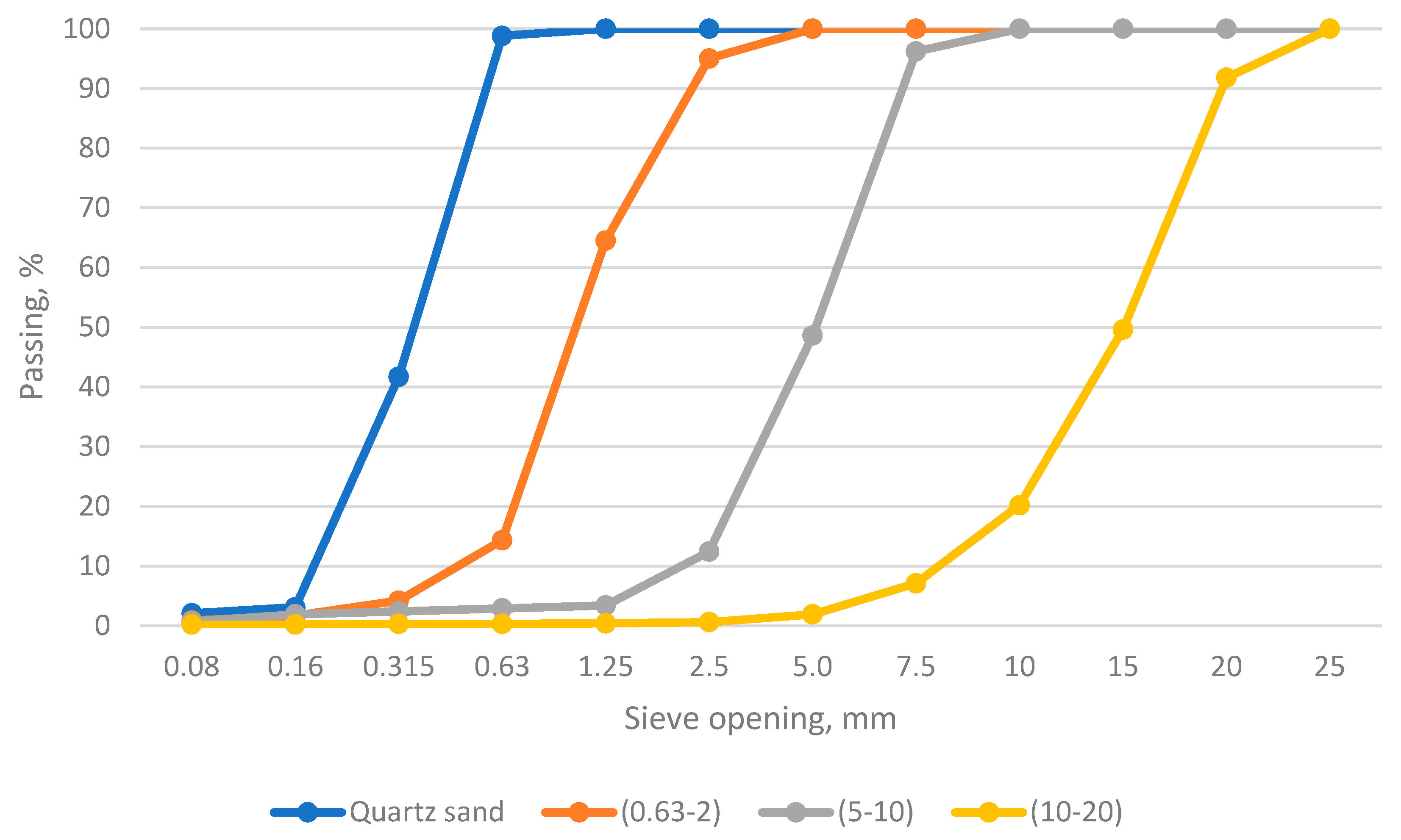

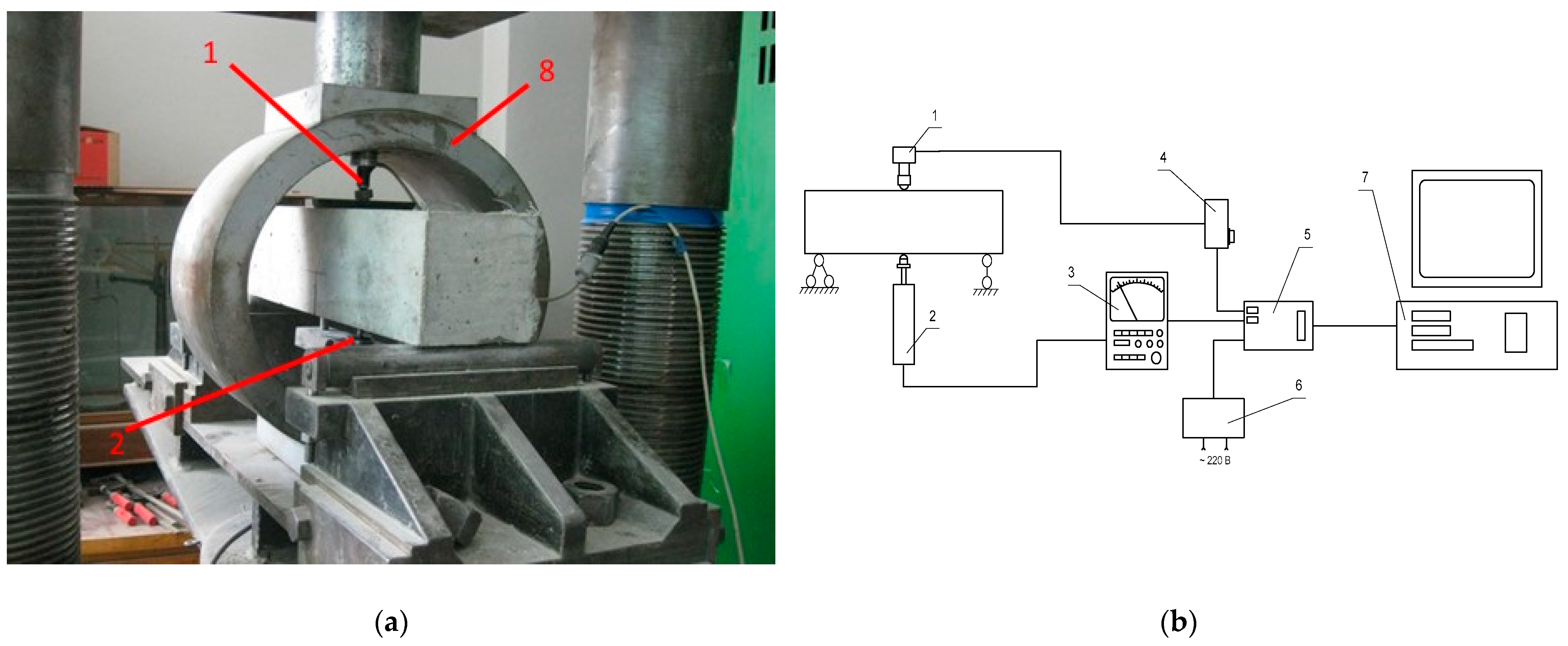
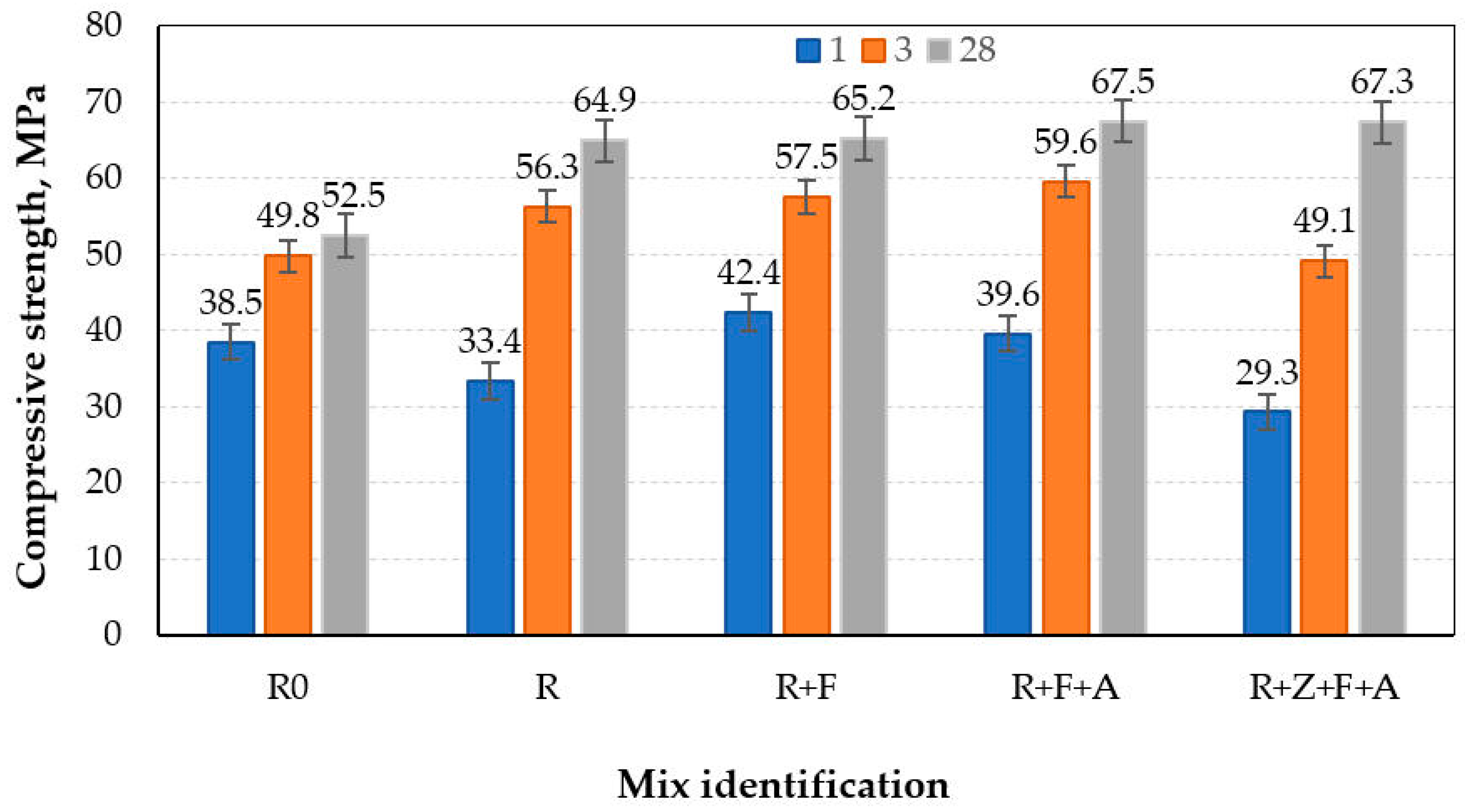
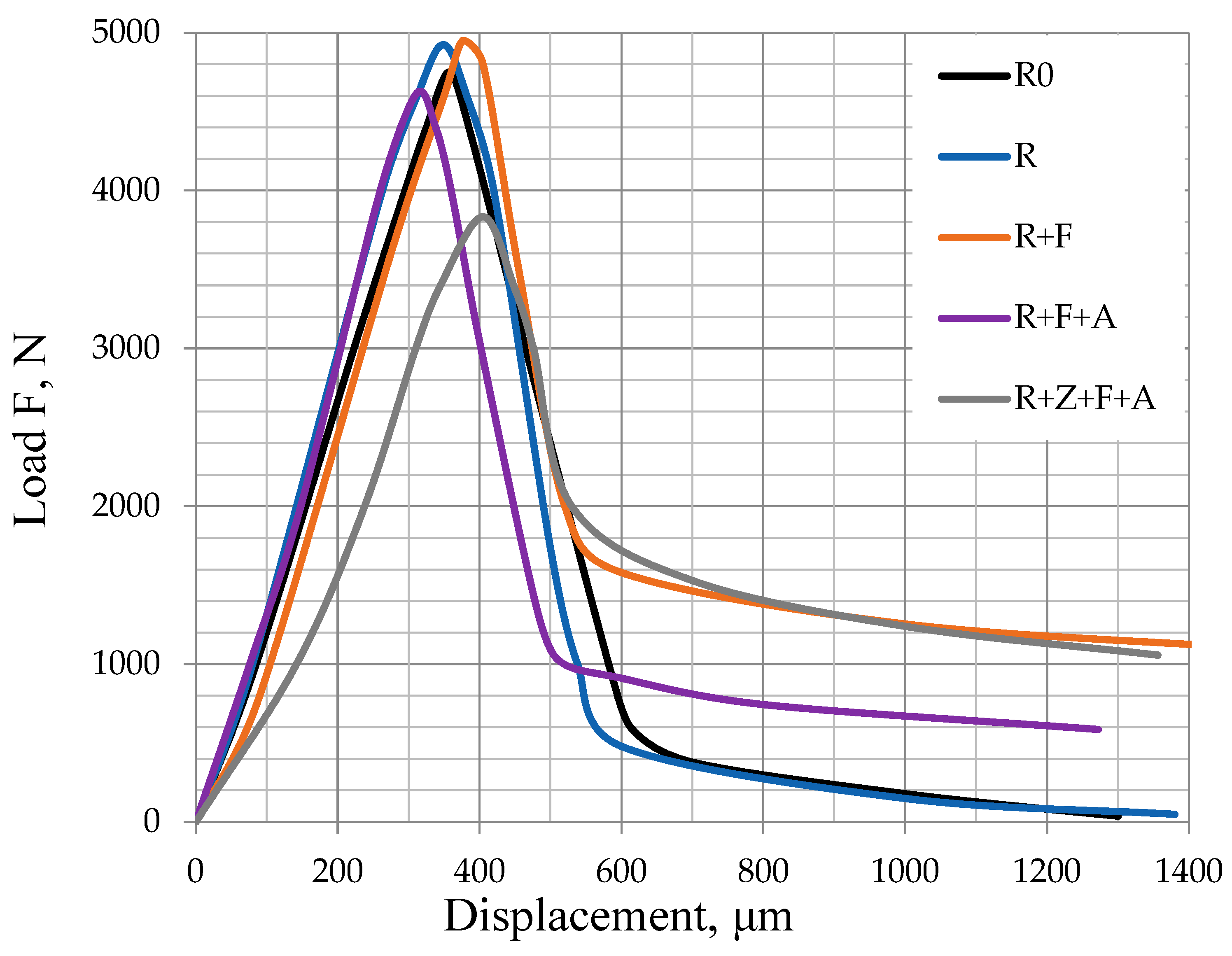

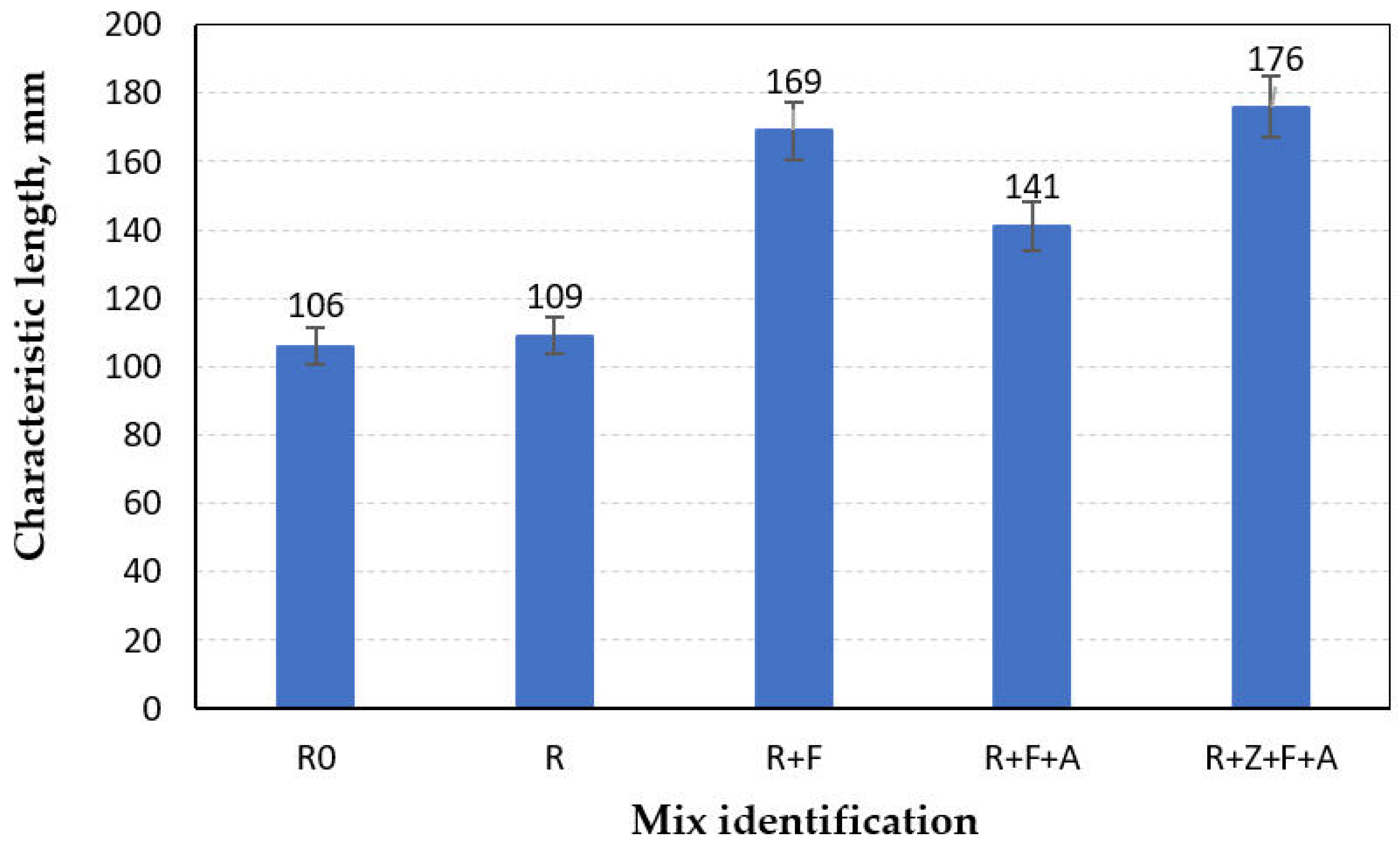
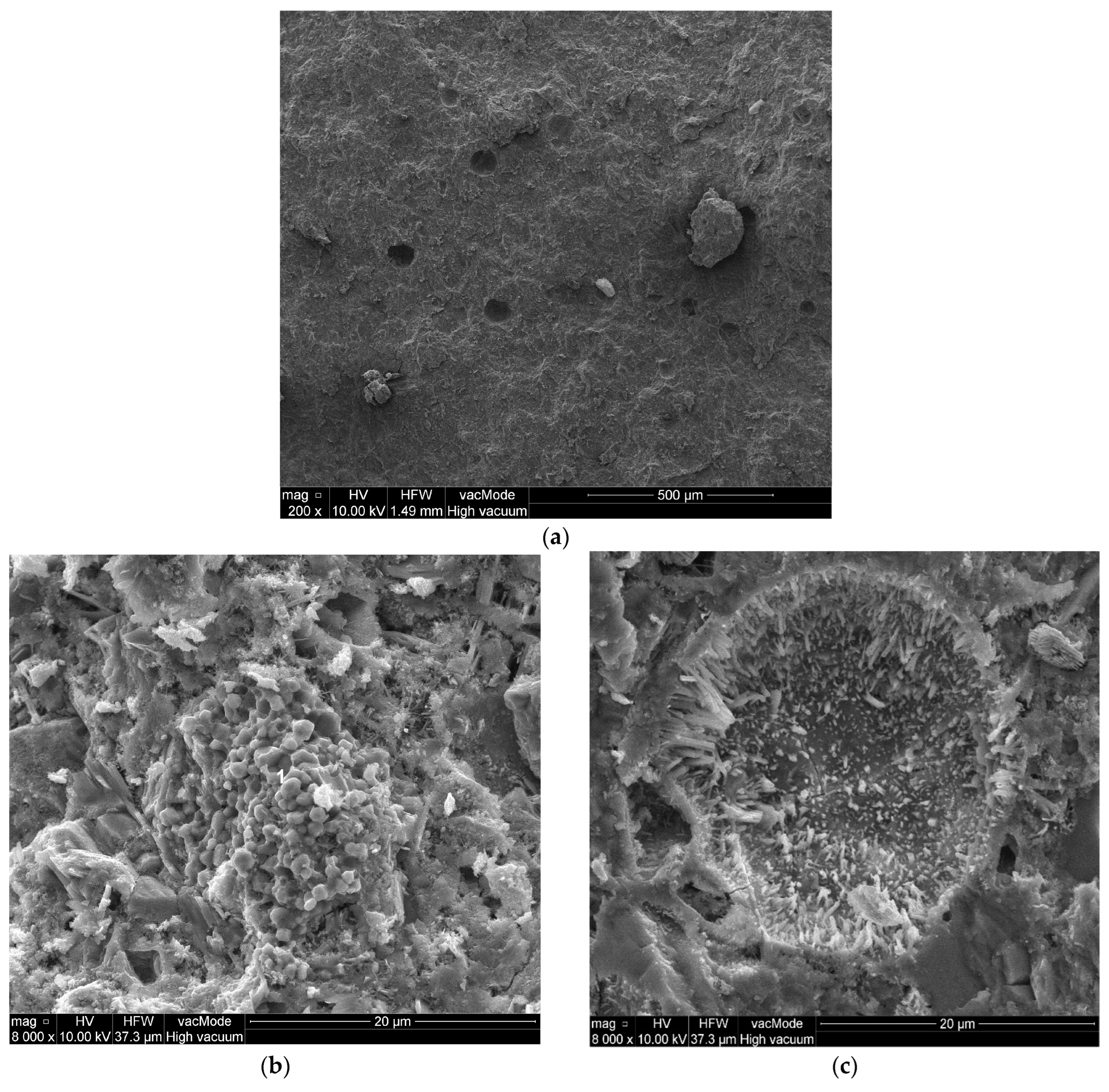
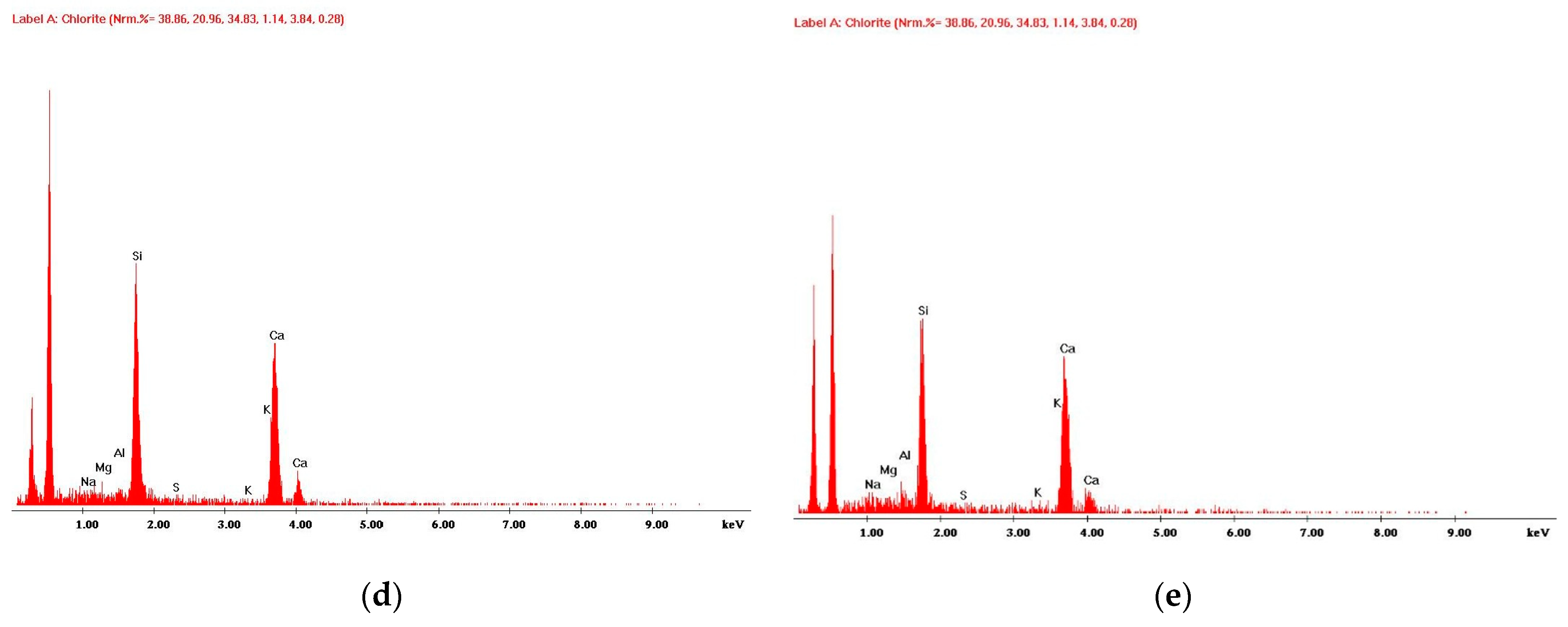
| Specific Surface, m2/kg | Residue on Sieve 008, % | Water Demand, % | Setting Time, min | Compressive Strength, MPa | ||
|---|---|---|---|---|---|---|
| Initial | Final | 2 Days | 28 Days | |||
| 350 | 2.6 | 29.0 | 140 | 230 | 27.1 | 54.2 |
| Material | CEM II/A-S 52.5N | Natural Zeolite | |
|---|---|---|---|
| Chemical composition, % | SiO2 | 22.96 | 77.64 |
| Al2O3 | 4.85 | 13.04 | |
| Fe2O3 | 3.59 | 2.90 | |
| CaO | 60.20 | 4.77 | |
| MgO | 2.04 | 1.60 | |
| SO3 | 2.40 | 0.05 | |
| LOI | 3.96 | - | |
| Aggregate Type | Density [g/cm3] | Bulk Density [kg/m3] | Voidage [%] | Dust and Clay Particles [%] | Fineness Modulus |
|---|---|---|---|---|---|
| Fine (quartz sand) | 2.63 | 1502 | 42.9 | 0.2 | 1.6 |
| Fine (crushed granite sand, 0.63–2 mm) | 2.66 | 1464 | 45.0 | 0.6 | - |
| Coarse (granite gravel, 5–10 mm) | 2.66 | 1428 | 46.3 | 0.2 | - |
| Coarse (granite gravel, 10–20 mm) | 2.66 | 1465 | 44.9 | 0.5 | - |
| Properties | Value | |
|---|---|---|
| Ordinary Polypropylene (PP) Microfiber | Polypropylene (PP) Macrofiber with Deformed Shape | |
| Fiber length | 12 mm | 45 mm |
| Shape of the cross-section | Round (Ø 18 ÷ 20 μm) | Rectangular (1.0 × 0.5 mm) |
| Aspect ratio | 630 | 56 |
| Type/form | Micro/monofilament | Macro/monofilament |
| Specific weight | 0.91 g/cm3 | 0.91 g/cm3 |
| Melting point | 162 °C | 164 °C |
| Flash point | 593 °C | >550 °C |
| Mix Identification | R0 | R | R+F | R+F+A | R+Z+F+A |
|---|---|---|---|---|---|
| Cement, kg/m3 | 450 | 450 | 450 | 450 | 405 |
| Zeolitic tuff, kg/m3 | - | - | - | - | 45 |
| Sand, kg/m3 | 400 | 400 | 400 | 300 | 300 |
| Crushed granite sand (0.63–2 mm), kg/m3 | - | 100 | 100 | 100 | 100 |
| Granite gravel (5.0–10 mm), kg/m3 | 400 | 370 | 370 | 370 | 370 |
| Granite gravel (10.0–20 mm), kg/m3 | 1000 | 930 | 930 | 930 | 930 |
| Superplasticizer, % by mass | 0.8 | 0.8 | 1.5 | 1.2 | 1.5 |
| Air-entraining admixture, % by mass | - | - | - | 0.4 | 0.4 |
| Fiber with deformed shape, kg/m3 | - | - | 8 | 8 | 8 |
| Ordinary microfiber, kg/m3 | - | - | 1.05 | 1.05 | 1.05 |
| The volume of the entrained air, % | 1.5 | 1.5 | 2.0 | 6.0 | 6.0 |
Disclaimer/Publisher’s Note: The statements, opinions and data contained in all publications are solely those of the individual author(s) and contributor(s) and not of MDPI and/or the editor(s). MDPI and/or the editor(s) disclaim responsibility for any injury to people or property resulting from any ideas, methods, instructions or products referred to in the content. |
© 2023 by the authors. Licensee MDPI, Basel, Switzerland. This article is an open access article distributed under the terms and conditions of the Creative Commons Attribution (CC BY) license (https://creativecommons.org/licenses/by/4.0/).
Share and Cite
Blikharskyy, Z.; Markiv, T.; Turba, Y.; Hunyak, O.; Blikharskyy, Y.; Selejdak, J. Mechanical and Fracture Properties of Air-Entrained FRC Containing Zeolitic Tuff. Appl. Sci. 2023, 13, 9164. https://doi.org/10.3390/app13169164
Blikharskyy Z, Markiv T, Turba Y, Hunyak O, Blikharskyy Y, Selejdak J. Mechanical and Fracture Properties of Air-Entrained FRC Containing Zeolitic Tuff. Applied Sciences. 2023; 13(16):9164. https://doi.org/10.3390/app13169164
Chicago/Turabian StyleBlikharskyy, Zinoviy, Taras Markiv, Yurii Turba, Oleksii Hunyak, Yaroslav Blikharskyy, and Jacek Selejdak. 2023. "Mechanical and Fracture Properties of Air-Entrained FRC Containing Zeolitic Tuff" Applied Sciences 13, no. 16: 9164. https://doi.org/10.3390/app13169164
APA StyleBlikharskyy, Z., Markiv, T., Turba, Y., Hunyak, O., Blikharskyy, Y., & Selejdak, J. (2023). Mechanical and Fracture Properties of Air-Entrained FRC Containing Zeolitic Tuff. Applied Sciences, 13(16), 9164. https://doi.org/10.3390/app13169164







